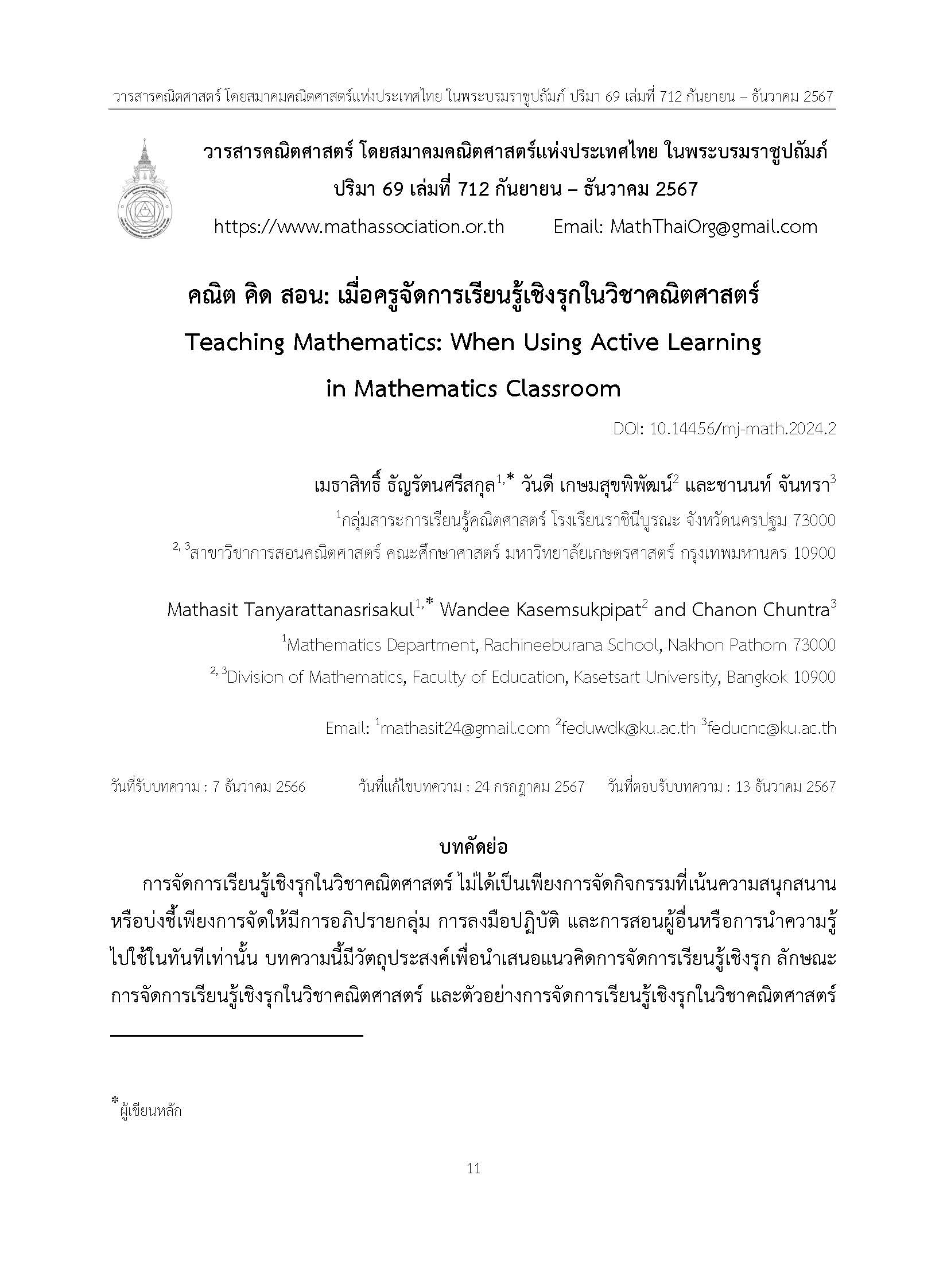คณิต คิด สอน: เมื่อครูจัดการเรียนรู้เชิงรุกในวิชาคณิตศาสตร์
Main Article Content
บทคัดย่อ
การจัดการเรียนรู้เชิงรุกในวิชาคณิตศาสตร์ ไม่ได้เป็นเพียงการจัดกิจกรรมที่เน้นความสนุกสนานหรือบ่งชี้เพียงการจัดให้มีการอภิปรายกลุ่ม การลงมือปฏิบัติ และการสอนผู้อื่นหรือการนำความรู้
ไปใช้ในทันทีเท่านั้น บทความนี้มีวัตถุประสงค์เพื่อนำเสนอแนวคิดการจัดการเรียนรู้เชิงรุก ลักษณะ
การจัดการเรียนรู้เชิงรุกในวิชาคณิตศาสตร์ และตัวอย่างการจัดการเรียนรู้เชิงรุกในวิชาคณิตศาสตร์ เรื่อง ทฤษฎีบทพีทาโกรัส สาระสำคัญของบทความ ประกอบด้วย 1) การจัดการเรียนรู้เชิงรุก เป็นการจัด การเรียนรู้ที่ส่งเสริมให้นักเรียนมีส่วนร่วมในกิจกรรมการเรียนรู้อย่างกระตือรือร้น ได้ใช้ความรู้ ทักษะ และกระบวนการคิดขั้นสูง เพื่อสร้างความรู้ด้วยตนเองจากการปฏิสัมพันธ์ทางสังคม ผ่านกลไกสำคัญของการเรียนรู้ คือ การดูดซึมประสบการณ์ และการปรับเปลี่ยนโครงสร้างความรู้ความเข้าใจ เพื่อให้เกิดความสมดุล 2) การจัดการเรียนรู้เชิงรุกในวิชาคณิตศาสตร์ มีลักษณะสำคัญ คือ การนำเสนอกิจกรรมทางคณิตศาสตร์ที่เชิญชวนให้นักเรียนมีส่วนร่วม การมีส่วนร่วมของนักเรียนในกิจกรรมเพื่อตอบสนองต่อความสงสัยใคร่รู้ การสะท้อนผลหลังกิจกรรมการเรียนรู้ และการเข้าร่วมและมีปฏิสัมพันธ์กับสังคม เพื่อสื่อสารและอภิปรายเกี่ยวกับแนวคิดทางคณิตศาสตร์ที่แฝงอยู่ในกิจกรรม และ 3) ตัวอย่างการจัดการเรียนรู้เชิงรุกในวิชาคณิตศาสตร์ เรื่อง ทฤษฎีบทพีทาโกรัส ซึ่งเป็นการจัด การเรียนรู้ผ่านกิจกรรมที่มีชื่อว่า “เรขาคณิตบนร่มแปดเหลี่ยม” เริ่มต้นจากการนำเสนอข้อมูลที่สร้างความสนใจ การจัดกิจกรรมให้นักเรียนได้ใช้คณิตศาสตร์หาคำตอบที่ตนเองตั้งไว้ การสะท้อนสิ่งที่ได้เรียนรู้ และการอภิปรายเพื่อสื่อสารแนวคิดทางคณิตศาสตร์ที่ตนเองได้รับ
Article Details
References
สำนักงานคณะกรรมการการศึกษาขั้นพื้นฐาน. (2560). ตัวชี้วัดสาระการเรียนรู้แกนลาง กลุ่มสาระการเรียนรู้คณิตศาสตร์ (ฉบับปรับปรุง พ.ศ. 2560) ตามหลักสูตรแกนกลางการศึกษาขั้นพื้นฐาน พ.ศ. 2551. กรุงเทพมหานคร: โรงพิมพ์ชุมนุมสหกรณ์การเกษตรแห่งประเทศไทย.
Office of the Basic Education Commission. (2017). Indicators and Core Content of Mathematics Learning Group (Revised edition 2017) According to the Basic Education Core Curriculum 2008. Bangkok: The Secretariat of the House of Representatives.
Bonwell, C. C. and Eison, J. A. (1991). Active Learning: Creating Excitement in the Classroom. Washington, D.C.: The George Washington University, School of Education and Human Development.
Boyer, K. R. (2002). Using Active Learning Strategies to Motivate Students. Mathematical Teaching in the Middle School, 8 (1), p. 48 – 51.
Dale, E. (1946). Audio-Visual Methods in Teaching. New York: The Dryden Press.
Draper, R. J. (1997). Active Learning in Mathematics: Desktop Teaching. The Mathematics Teacher, 90 (8), p. 622 – 625.
Driscoll, M. P. (2014). Psychology of Learning for Instruction. US: Pearson.
Fedler, R. M. and Brent, R. (1996). Navigating the Bumpy Road to Student–Centered Instruction. College Teaching, 44 (2), p. 43 – 47.
Glasersfeld, E. V. (1990). An Exposition of Constructivism: Why Some Like It Radical, in Davis, R.B., Maher, C.A. Noddings, N. (Eds.), Constructivist View on the Teaching and Learning of Mathematics (p. 19 – 29), Reston: National Council of Teachers of Mathematics
Masalski, W. J. (1978). Mathematics and the Active Learning Approach. Arithmetic Teacher, 26 (2), p. 10 – 12.
National Council of Teachers of Mathematics. (2016). NCTM Supports CBMS’s Efforts for Active Learning in the Classroom. Retrieved 1 October, 2023, from https://www.nctm. org/News-and-Calendar/News/NCTM-News-Releases
National Council of Teachers of Mathematics. (2023). Notice and Wonder: Umbellar 7-10. Retrieved 22 September, 2023, from https://www.nctm.org/ Classroom-Resources /Features/Notice-and-Wonder/Lesson-Plans/downloads/ Umbrella-7-10/
Reinholz, D., Johnson, E., Larson, C. A., Johnstone, A. S., Smith, J., Mullins, B., Fortune, N., Keene, K. and Shah, N. (2022). When Active Learning Is Inequitable: Women’s Participation Predicts Gender Inequities in Mathematical Performance. Journal for Research in Mathematics Education, 53 (3), p. 204 – 226.
Smith, J. (1999). Active learning of Mathematics. Mathematical Teaching in the Middle School, 5 (2), p. 108 – 110.

